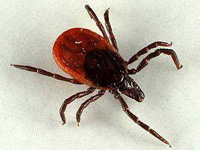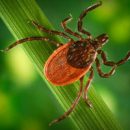Ixodic ticks are known for carrying pathogens of many diseases. One of the most terrible diseases carried by these ticks is mite encephalitis. So what we know about these little insects?
Content
Ixodic ticks
Ixodic ticks (lat. IXodidae) rather major tick family, numbering about a thousand species. All ixodic ticks are temporary parasites that suck blood in animals and man.
The length of the tick is from 2.5-4mm in the hungry state up to 10 mm after bloodsucm. Body Color
Hungry ticks are usually yellow-brown, brown-brown, right up to black. To see more detail how the Ixodic tick can enter the photo.

The body of the tick is covered with a chitine shield. The tick-tick female covers no more than half of the body surface, due to which during bloodscay their body is strongly stretched. The males shield covers the body completely, so they cannot be very stretched, using a small amount of blood. By the magnitude of the chitine flap, the female can easily distinguish from male.
The oxodic tick rotter apparatus adapted for piercing the skin and sucking blood contains special trumps into the composition of which includes Helicers and additional education - hypostite. Tick hyposite - this is an extended folded grown with sharp directed by the pin. With the help of serrated sharp Helizer tick pierces the skin, forming a wound on the skin of the owner, in which it is immersed by hypostite. The first portion of saliva, which is injected with a tick in the wound when the bite is frozen around the trunk, firmly fixing the tick on the skin.
Miles of ticks are suited for a short time only in order to replenish the supply of nutrients in the body. Cleaning female can eat up to 15-20 days, increasing to 10mm. Drinking female acquires a dirty gray color with a metallic tint, with its weight
increases more than a hundred times.
After powering the tick female, several thousand eggs in the cracks of the soil, forest litter and rodent holes. The cycle of the development of Ixodic ticks includes an egg and 3 active stages - larvae, nymph and a warm-creation tick. During this transformation, most Ixodic ticks replaces three owners. Such a cycle of development is called threehow.
From the egg hatching larvae having three pairs of legs. It is usually powered once on small mammals (rodents). The larva drops on the ground, lines and turns into nimph. It is larger and has already four pairs of legs. Nymph feeds on hares, squirrels, hedgehogs, rats. After power, she again lines, turning into a half-arms - Imago. Adult tick usually sucks the blood of domestic and wild animals and man.
Than dangerous pincers
Adult Ixodic ticks are dangerous in that they transfer pathogens of various diseases. Among all ixodic ticks for a person are the following types of pathogens for a person: Taiga tick (Ixodes Persulcatus), a dog tick (Ixodes Ricinus), and the pits of the genus DermatoCenter (pasture ticks) and Hyalomma. These ticks are able to endure pathogens of diseases such as tick-in-enephalite, borreliosis, tularemia, mite
Tif, hemorrhagic fever, etc. Among them are most famous for tick-free spring-summer encephalitis.
On the territory of Russia, the main carriers of the tick-borne encephalitis virus are two types of ticks - taiga tick and a dog tick.
Dog tick is common in a wide geographical range. Ticks of this species are usually found in forests, shrub thickets of the European part of Russia and the countries of Central and Northern Europe. The dog tick is well tolerate low temperatures and can be starved for several years.
Taiga tig is common in taiga forests all over the Urals to Primorye, as well as in the central regions of the European part of Russia in the zones of mixed forests. This type of tick is especially dangerous, as they often attack a person.
The habitat area of these types of ixodic ticks intersect. Therefore, there are places where both types are found.
Where did Encephalite mites come from
The source of infection of the Ixode Ticks of the tick-borne encephalitis virus is wild forest animals. The animals themselves do not hurt or sick in a light form, but in their body the virus is actively multiplied by. Obvious when bloodsucked in the body of the tick, the viruses multiply, accumulating including in salivary glands and ovaries. As a result, under the subsequent bloodstream, the tick-borne encephalitis virus is transmitted by the next owner, t.E. Transmissive transmission. It is also possible to transfer the virus by females of the tick offspring during the egg laying, T.E. Transvarial Transmission.
Say in appearance encephalitis is a tick or not impossible. The tick-borne encephalitis virus may also be in the larvae, and in nymphs and in hawk individuals. Determine whether an xodek mite is encephalitis or not, you can only examine it.
It is known that the number of encephalitite ticks is different in different regions. So, for example, in the European territory of Russia, the encephalitis virus is infected with no more than a few percent of all ticks, and in Siberia and in the Far East, encephalitite mites are found much more often, and this figure can reach up to 20%. Therefore, it is in these areas that the incidence of people with tick-borne encephalitis.









